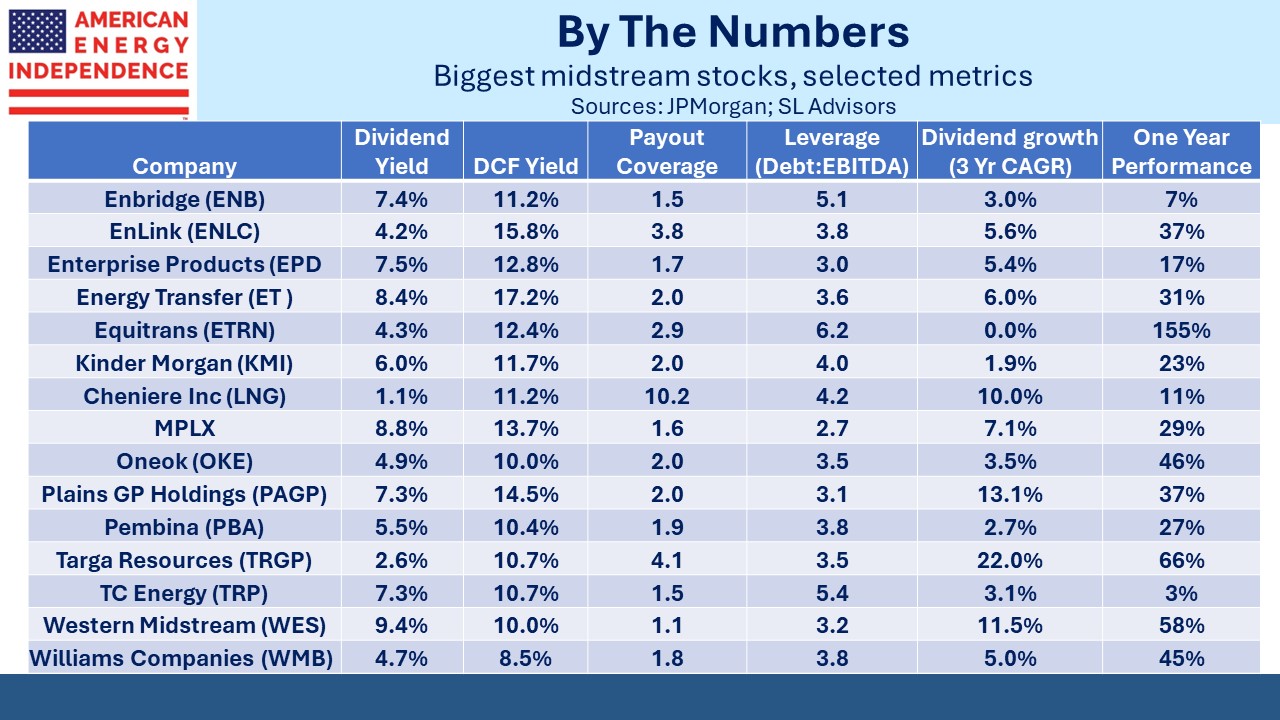Picking The Top Pipeline
Which is the best pipeline company? It depends on what you’re measuring. Income-seeking investors might focus on Distributable Cash Flow (DCF) yield or distribution (dividend) yield. Dividend coverage is usually important. Lowest leverage would provide comfort to those concerned about downside. Momentum investors will look at dividend growth – and few will ignore price performance. So how do they rate?
We’ll focus on the biggest companies and MLPs, all part of the American Energy Independence index (AEITR). If DCF yield is what you’re after, Energy Transfer (ET) is top at 17.2%. For years this stock labored under the “Kelcy discount” as potential buyers were wary of past management actions that weren’t fiduciary best practice (see A Look Back At Energy Transfer).
However, this company knows how to execute. Last year’s acquisition of Crestwood has been absorbed with more synergy benefits than forecast. Many advisors we talk to own ET, and their reputation has evolved away from most likely to self-deal to great operator with an “in-your-face” posture to competitors and regulators.
One investor said he’d heard that some analysts are downgrading ET, but JPMorgan and Wells Fargo both reaffirmed Overweight ratings following earnings earlier in the month.
The highest dividend yield is Western Midstream Partners (WES) at 9.4%. Their DCF yield is only 10%, giving them a scant 1.1X coverage. It’s many years ago now but low distribution coverage ratios used to be typical when MLPs were the dominant corporate form in midstream energy infrastructure. They were routinely doing secondary offerings to buy “drop-down” assets from their controlling general partner.
The shrinking pool of MLP-oriented money forced a more conventional single entity c-corp structure on most of the industry. Giving up the partnership structure meant accepting the double taxation common to most equity securities (ie first on corporate profits then on dividends paid to owners).
Depreciation charges help lower taxable income in many cases.
The best payout coverage is a whopping 10.2X at Cheniere. Their DCF yield of 11.2% is close to the median. They paid their first dividend in November 2021. It’s grown by a third since then but still only represents a derisory 1.1%. One of the features we like about Cheniere is that once an LNG terminal is built its ongoing maintenance capex is low. As a % of EBITDA Cheniere has the lowest ratio in the industry.
Pipelines have been reducing leverage in what’s become a virtuous cycle. Falling capex, caused in part by opposition from climate extremists, has boosted free cash flow. This has allowed some debt paydown as well as driving EBITDA higher. MPLX currently has the lowest Debt/EBITDA of 2.7X.
The two big Canadians, Enbridge (ENB) and TC Energy (TRP), have both been bucking this trend (5.1X and 5.4X respectively) with big capex programs and (in ENB’s case) acquisitions. This has caused their stocks to lag the market, although both are continuing to raise dividends and reduce leverage.
Growth, as measured by three-year CAGR in payout, is distorted by companies that have significantly increased their payout ratio. Hence Targa Resources (TRGP) is top with a 22% CAGR having raised their annual payout from $2 per share in 2023 to an estimated $3.63 (re JPMorgan). More representative growth rates from companies that were always paying a reasonable dividend are Williams Companies (5%), ET (6%) and MPLX (7.1%).
When it comes to trailing one year performance, Equitrans is the clear winner with a +155% return. Resolution of Mountain Valley Pipeline (MVP) thanks to its inclusion in a debt ceiling bill makes Senator Joe Manchin (WVa) their MVP.
In 2022 NextEra, a JV partner in MVP, was so pessimistic about the prospects of completion that they wrote down their interest to zero (see Why Pipeline Construction Is Hard). The repeated delays and cost overruns show why making the permit process more predictable is so important to all kinds of energy infrastructure, especially renewables. If courts can rescind authorizations years after the fact, building big projects will carry an additional layer of risk.
Other strong performers over the past year include TRGP (+66%), WES (+58%) and Oneok (+46%). I received a hefty tax bill due to their acquisition of Magellan Midstream (MMP) last year, which we and others opposed (see Still Uncovinced By Oneok Magellan Combo).
Since New Jersey doesn’t recognize tax loss carryforwards, the gain on MMP which I’d held for close to two decades was fully taxed on my state return while my federal return allowed some older losses to offset.
The NJ tax code is the most effective tool for encouraging those with means to flee the state. Fortunately, the OKE-MMP combination has performed better than expected.
Whichever metric you prefer in selecting stocks, midstream energy infrastructure has names that measure up well. It’s why the sector continues to outperform.
We have three have funds that seek to profit from this environment:
